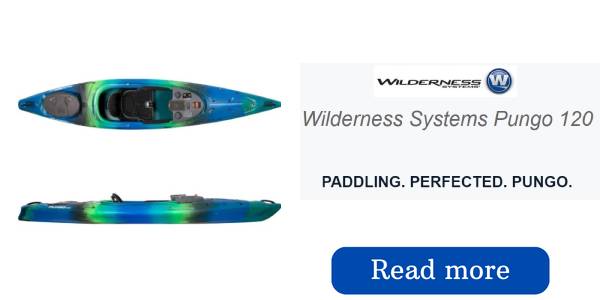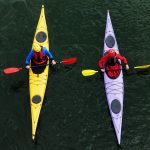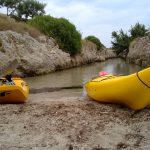When it comes to selecting a kayak paddle, there are a variety of options to choose from.
One important factor to consider is the angle of the blade in relation to the shaft, as this can greatly impact your paddling experience. In general, there are two main types of kayak paddles: high angle and low angle.
Both options have their benefits and drawbacks, depending on your paddling style and experience level.
In this article, we’ll explore the differences between high angle versus low angle kayak paddles, and help you determine which option is best for you.
what is a high angle kayak paddle?
A high angle kayak paddle is a type of paddle that is used for kayaking at a faster pace or in rougher water conditions. Unlike a low angle paddle, which is designed for a more relaxed and leisurely paddling experience, a high angle paddle has a shorter, wider blade that is angled more aggressively.
This design allows the paddler to generate more power with each stroke and maintain a higher speed.
One of the main advantages of using a high angle kayak paddle is its efficiency. The shorter, wider blade allows for a quicker and more powerful stroke, which can help you cover more distance in less time. Additionally, the angle of the blade allows for a more vertical stroke, which is better suited for choppy or windy conditions.
Another benefit of using a high angle paddle is its versatility. While it is often used for more aggressive paddling styles, it can also be used for more leisurely trips. This means that you can invest in a high quality high angle paddle and use it for a variety of different kayaking adventures.
In conclusion, a high angle kayak paddle is an essential piece of equipment for any kayaker looking to take their skills to the next level. Whether you are looking to paddle faster, tackle rougher waters, or simply improve your overall efficiency, a high angle paddle can help you achieve your goals and enhance your kayaking experience.
what is a low angle kayak paddle?
A low angle kayak paddle is a type of paddle that is used for a more relaxed and leisurely kayaking experience. Unlike a high angle paddle, which is designed for more aggressive and fast-paced paddling, a low angle paddle has a longer, narrower blade that is angled less aggressively.
This design allows the paddler to maintain a slower, more consistent pace with less effort.
One of the main advantages of using a low angle kayak paddle is its efficiency. The longer, narrower blade allows for a smoother, more fluid stroke, which can help you conserve energy and maintain your speed over longer distances.
Additionally, the lower angle of the blade means that it can be used in calmer waters without creating too much disturbance or spray.
Another benefit of using a low angle paddle is its comfort. The longer, more gradual stroke allows for a more relaxed and natural paddling motion, which can help prevent strain or fatigue in your shoulders and arms. This makes it a great option for longer kayaking trips or for those who are looking to enjoy a more leisurely pace.
In conclusion, a low angle kayak paddle is a versatile and efficient option for kayakers of all levels. Whether you are looking to enjoy a relaxing day on the water or to cover longer distances with less effort, a low angle paddle can help you achieve your goals and enhance your kayaking experience.
high angle versus low angle kayak paddles – what are the differences?
Let’s have a look at the characteristics of the high angle kayak paddles and the low angle kayak paddles, which makes them different…
paddle shaft length
When it comes to kayak paddles, the length of the shaft is an important consideration, especially in relation to the difference between high and low angle paddles.
For high angle paddles, a shorter shaft is typically preferred. This is because a shorter shaft allows the paddler to keep their hands closer together, which can help increase their power and control during more aggressive paddling.
Additionally, a shorter shaft allows for quicker and more efficient strokes, which can be important when navigating rough waters or rapids.
On the other hand, low angle paddles are typically used with longer shafts. This is because the longer shaft allows the paddler to keep their hands further apart, which can help reduce fatigue and strain during longer paddling trips.
Additionally, the longer shaft allows for a smoother and more relaxed paddling motion, which is well-suited for calmer waters or for those who prefer a more leisurely pace.
Ultimately, the length of the shaft will depend on your personal preferences and the type of paddling you plan to do. However, it is important to consider the differences between high and low angle paddles when choosing the length of your shaft.
By selecting the right paddle and shaft length for your needs, you can help ensure a more comfortable and enjoyable kayaking experience.
paddle profile
The blade profile of a kayak paddle is another important consideration when choosing between high and low angle paddles.
For high angle paddles, the blade profile is typically wider and shorter. This design allows for a more aggressive and powerful stroke, which can be important when navigating rougher waters or when paddling at a faster pace. Additionally, the wider blade profile can help generate more lift, which can be useful when performing maneuvers like edging or bracing.
On the other hand, low angle paddles typically have narrower and longer blade profiles. This design allows for a smoother and more relaxed paddling motion, which is well-suited for calmer waters or for those who prefer a more leisurely pace.
The narrower blade profile also creates less resistance and drag, which can help conserve energy during longer paddling trips.
Ultimately, the blade profile will depend on your personal preferences and the type of paddling you plan to do. However, it is important to consider the differences between high and low angle paddles when choosing the blade profile that is right for you.
By selecting the right paddle and blade profile for your needs, you can help ensure a more comfortable and enjoyable kayaking experience.
Which paddle should you choose?
for some kayakers a high angle paddle is more suitable, while for others a low angle paddle is the best option.
Find below a list for both use cases:
high angle kayak paddle
- Want to paddle at a faster pace
- Are paddling in rougher water conditions
- Want to generate more power with each stroke
- Want to cover more distance in less time
- Are comfortable with a more aggressive paddling style
- Want to maintain a higher speed while paddling
- Prefer a more vertical stroke for better performance in choppy or windy conditions
- Want to invest in a versatile paddle that can be used for both aggressive and leisurely paddling styles
low angle kayak paddle
- Want a more leisurely paddling experience
- Prefer a more relaxed paddling style
- Are paddling in calm or flat water conditions
- Want to conserve energy during longer paddling trips
- Want a paddle that is more comfortable for their shoulders and arms
- Want to use a paddle that is better suited for touring and exploring
- Want a smoother and more efficient stroke for longer distances
- Want to invest in a versatile paddle that can be used for both aggressive and leisurely paddling styles
Advantages of high angle paddle vs Low Angle paddle technique
Canoeing can be done utilizing two techniques: High or low angle. They all possess their own individual approach, use, disadvantages, and advantages. The type of kayak you should use will be determined by the type of kayaking you are doing, how experienced you are, and how well-conditioned you are.
Why Does it Matter How You Paddle?
Kayaking offers various applications for its boats. Kayaks are produced for pastimes, excursions, unstable rapids, angling, and ocean voyaging. The varying circumstances of each of these settings will require you, the kayaker, to respond differently.
The significance of having proper paddling skills is apparent here.
Low-Angle Paddling Technique
Low-angle paddling is all about efficiency. This technique requires less physical fitness and is simpler to acquire. This makes it perfect for enjoyable kayaking excursions, extended time on the water, basic touring and those just starting to paddle. If you are on a leisurely stroll, it is best to use a low angle perspective.
One of the main benefits of using a low angle stroke is that it is very efficient in motion. This increases ease and reduces the tension on your muscles and joints. Low angle paddling is an optimal choice for people who have suffered any injuries, as well as those with limited physical fitness or mobility issues.
The disadvantage of using a paddle with a low angle is that it is harder to keep a straight course. The reason that the kayak tends to shift from left to right slightly is because during the stroke, the paddle is maneuvered laterally more and due to the longer size of the paddle blade. It won’t be too hard to maneuver your boat, but you may need to take some extra steps to ensure that you stay on course.
High-Angle Paddling Technique
Paddling at a steep angle is a more aggressive form of technique that focuses on delivering good results. Using a high arm swing will allow you to generate more potency and velocity. When needing to move quickly, navigating around objects or catching a quickly passing wave, you must employ a high-angle paddling technique.
Here’s a list of activities where you high-angle paddling is common:
- Whitewater kayaking is a perfect example of an environment in which you need to move quickly and in different directions. In whitewater kayaking, high angle paddling is used almost exclusively. Without the ability to avoid obstacles and move faster than the water, you can easily find yourself in a bad situation!
- Sea kayaking is very different to whitewater, but also calls for a higher angle stroke. Due to their width and length, sea kayaks are perfect for high angle paddling. A narrower hull makes access to the water much easier than a wider, more stable boat. Sea kayaks are also made to track very straight and cover long distances which again suits high angle paddling.
- Kayak surfing is another instance where a high angle is called for. Catching and riding waves requires you to move faster than the water. You can’t afford to cruise along at a relaxed pace when a wave is rushing towards you! In this environment, only high-angle paddling will do.
In the event that you have a significant amount of weight in your vessel while kayaking and camping and need to generate lots of force, the high-angle paddling method may be beneficial. Paddles with a low angle will not be able to generate the power needed to maintain a acceptable speed for your vessel.
Kayak fishermen may deem the high-angle paddling technique the most beneficial because their elevated seating position can make it difficult to reach the water without utilizing a lengthy paddle.
Those seeking to strengthen their physique by kayaking should look into employing a high-angle paddle technique; this technique will be more exacting on the body’s muscles and cardiovascular functioning.
The main disadvantage to paddling at a steep angle is that it takes more advanced skills. This will take more time to learn. It is necessary to have the correct skills in order to paddle at a steep angle without becoming overly fatigued.
It is clear that both strategies present both pluses and minuses. In certain cases, there may be an overlap in the way people paddle. For instance, if you would like to increase your velocity on calm water, there is nothing preventing you from bringing the oar up at a higher angle.
Angling the paddle at a high or low angle is not a matter of superiority, but rather a case of which style is more suitable for the specific type of kayaking. The same can be said for low angle paddling.
choosing the right paddle length – high angle vs low angle paddle size
Choosing the right paddle length is crucial to ensuring a comfortable and efficient kayaking experience, especially in relation to the high and low angle paddling styles.
For high angle paddles, a shorter paddle length is typically recommended. This is because a shorter paddle allows for a more aggressive and powerful paddling style, which is well-suited for navigating rougher waters or paddling at a faster pace.
A shorter paddle also allows the paddler to keep their hands closer together, which can help increase control and power during each stroke.
On the other hand, low angle paddles are typically used with longer paddle lengths. This is because a longer paddle allows for a more relaxed and efficient paddling style, which is ideal for calmer waters or for those who prefer a more leisurely pace.
A longer paddle also allows the paddler to keep their hands further apart, which can help reduce fatigue and strain during longer paddling trips.
Ultimately, the length of your paddle will depend on your personal preferences and the type of paddling you plan to do. A good rule of thumb is to choose a paddle length that allows for a comfortable grip with your hands positioned shoulder-width apart.
This will help ensure a comfortable and efficient paddling experience.
When choosing a paddle length, it is important to also consider the width of your kayak. A wider kayak will typically require a longer paddle, while a narrower kayak will require a shorter paddle.
Additionally, your height and paddling style should also be taken into account when selecting the appropriate paddle length.
By selecting the right paddle length for your needs and paddling style, you can help ensure a more comfortable and enjoyable kayaking experience. Whether you prefer a high or low angle paddling style, the right paddle length can make all the difference.
torso height and kayak paddle length
If you’re looking to kayak and want to maximize your paddling efficiency, selecting the right paddle size is essential. One factor to consider is your torso height. Your torso height determines the length of paddle that is best suited for you.
In this article, we’ll explore how to determine your torso height and choose the right paddle size.
What is torso height?
Torso height is the distance between your seat and the top of your shoulders. This measurement is important because it determines the length of paddle that will allow you to paddle with the most efficiency.
How to measure your torso height?
To measure your torso height, sit on a flat surface with your back straight and measure the distance from the surface to the top of your shoulders.
Choosing the right paddle size
Once you have determined your torso height, you can choose the right paddle size. The general rule of thumb is that the paddle should be roughly the same length as your torso height. However, this can vary depending on the type of kayaking you plan to do.
Best way to size a kayak paddle in person
Selecting the right size kayak paddle is crucial for a comfortable and efficient paddling experience. If you’re shopping for a new kayak paddle in person, there are several things you can do to ensure that you choose the right size. In this article, we’ll explore how to size a kayak paddle in person, step-by-step.
Step 1: Determine your paddling style
Before you start sizing a kayak paddle, it’s important to consider your paddling style. Different paddling styles require different paddle lengths. For example, if you plan on using your kayak for leisurely paddles around calm waters, a shorter paddle may be more suitable. If you plan on paddling in rougher waters or for long distances, a longer paddle may be necessary.
Step 2: Measure your torso height
Next, measure your torso height. This is the distance between your seat and the top of your shoulders. This measurement will help determine the appropriate paddle length for you.
Step 3: Select a paddle
Once you have an idea of the appropriate paddle length for your paddling style and torso height, it’s time to select a paddle. If you’re in a kayak shop, the staff can help you choose a paddle that fits your needs.
Step 4: Check the fit
Once you’ve selected a paddle, it’s time to check the fit. Hold the paddle vertically with one hand on the top and the other on the shaft, near the blade. The blade should be facing away from you. If the paddle fits correctly, your hands should be roughly shoulder-width apart. If the paddle is too long or too short, adjust accordingly.
Step 5: Test it out
Before you purchase a paddle, it’s a good idea to test it out. Head to the water and try out the paddle to ensure that it feels comfortable and efficient. Make sure the paddle length allows you to paddle with ease and doesn’t put unnecessary strain on your body.
final thoughts
Sizing a kayak paddle in person is a great way to ensure that you select the right size for your paddling style and body. By considering your paddling style, measuring your torso height, selecting an appropriate paddle, checking the fit, and testing it out, you can find a paddle that allows you to paddle with maximum efficiency and comfort.
in conclusion
Choosing the right kayak paddle for your paddling style is essential to ensure a comfortable and efficient experience on the water. When it comes to selecting between high angle versus low angle kayak paddles, it ultimately comes down to your personal preference and paddling style.
High angle paddles are great for more aggressive paddling styles, such as whitewater or surfing. They provide more power with each stroke, allowing you to navigate through rough waters with ease.
Low angle paddles, on the other hand, are great for recreational paddling or longer paddling distances. They are designed to provide a smoother, more relaxed paddling experience, making them perfect for those who prefer a leisurely pace on the water.
Ultimately, it’s important to consider your paddling style, experience level, and personal preference when choosing between high angle versus low angle kayak paddles.
By doing so, you can select a paddle that allows you to paddle with maximum comfort and efficiency, and enjoy your time on the water to the fullest.




